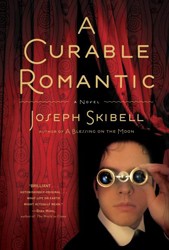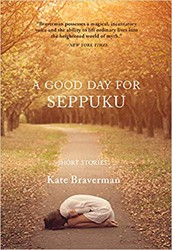Sara Houghteling’s powerful debut novel takes place in World War II-era Paris and brings to life the story of the Nazis’ massive and organized theft of the city’s artistic masterpieces. At the center of the novel is Max Berenzon, the overlooked son of a prominent gallery owner. When the Berenzons return out of hiding to find their entire collection stolen, it is Max who throws himself into a quest to recover the art, even against his father’s wishes.
Rich with romance and direct in the face of the war’s atrocities, Max’s journey is one that uncovers both stories of the Nazi invasion as well as long-buried secrets of his own family’s past. The innumerable pieces of the city’s stolen art — some disappeared forever, many with no one to claim them — come to embody with vivid force the enormous loss of this time. And yet in Houghteling’s vivid prose and deftly woven narrative, we cannot help but feel the presence of irrecoverable beauty always hovering near.
Interview
Set in Paris in the World War II era, Sara Houghteling’s debut novel, Pictures at an Exhibition, is poignant and elegant, sophisticated yet tangible, and — perhaps most importantly — an incredibly satisfying read. The story follows Max Berenzon, son of a prominent art dealer, as he searches for his father’s stolen masterpieces and, in the process, uncovers his family’s haunting past. Houghteling is a graduate of Harvard College and received her MFA from the University of Michigan. The recipient of a Fulbright scholarship to Paris, she lives in Berkeley, California, where she teaches high school English.
Arielle Listokin: Is it true that it took you six years to write this book?
Sara Houghteling: Actually, it took me eight years to finish the book — I was so consumed by this story that I just never wanted to leave it or let it go.
AL: How would you describe your novel?
SH: It is, of course, the story of a Paris art dealer and his son who goes in search of their looted art after World War II, but it is also so much more…it centers around a family tragedy and a secret that taints and impacts the lives of all the characters.
I love it when people tell me about the core that resounded most strongly with them. It’s hard for me to see if one theme stands out more than another. I would describe it as a book about this family and the ways in which art comforts these individuals and the ways in which it is a reminder of a painful past and what’s been lost that can never be recovered.
AL: How did the idea for the book come to you?
SH: My grandfather worked in France for the Marshall Plan after the war and my father lived there as a boy, so my interest in France and post-war France was always very strong. I also always wanted to write about art. When I discovered that there were paintings missing from the war and the story of Rose Valland whose covert actions allowed for the eventual repatriation of much of the looted art, I became intrigued by the mystery of her life and her story — that was the spark that drove the engine. The character of Rose Clément, who plays such a pivotal role in the book, takes her name and story from Rose Valland.
I was also inspired by the story of Paul Rosenberg and his family. I found out that there was this Jewish art dealer who was so essential to the Paris art world, who mentored and fostered Picasso and allowed him to be so creative. I don’t think the Paris art world has ever recovered from what happened — the period before World War II was a golden age, both for the art dealers and the artists.
AL: Would this book have been written without your own experience in France?
SH: From a reasonably young age, I was in love with France. If I hadn’t gone there, it would have been very hard to write this book. Altogether I spent about two years in Paris, first as a teacher at the American School and then later as a Fulbright scholar. One of the secret, personal pleasures of this book for me is that it is geographically autobiographical. Rose’s apartment with the pull-out bed and the shoe-shaped bathtub is my old apartment in the 6th arrondissement.
AL: Why did you name the book Pictures at an Exhibition?
SH: It is named after a musical piece that was composed by Mussorgsky for his friend, the painter Victor Hartmann who died at a young age. The piece is the “soundtrack” to an exhibition of Hartmann’s work and is meant to accompany Mussorgsky as he walks from piece to piece in Hartmann’s memorial exhibition. The tragic irony is that Hartmann’s paintings, which were the inspiration for Mussorgsky’s Pictures at an Exhibition, were lost. There is this resonance of the theme of lost art, a lost friend, and the afterimage of what remains following a tragedy.
AL: What do your high school students think about having a teacher who is a published author?
SH: The thing they are most impressed with is that I have a Wikipedia page! Being reviewed in The New York Times doesn’t compare to being on Wikipedia.
AL: Do you think of yourself as a teacher or as a writer?
SH: For me, teaching and writing complement each other very well. I hope always to be a writer who teaches and a teacher who writes.
AL: Are you working on something new?
SH: I’m working on a new book about two brothers who are pianists. It focuses on a Brahms’ concerto that’s infamously difficult and known for ruining pianists’ hands. This novel takes place in Brookline, Massachusetts, where I grew up. I thought that maybe I could shave a few years off the publication time by setting it in a place I am really familiar with and where they speak English!
AL: What does it mean to you to be part of the Jewish Book Network?
SH: I recently came back from the conference and I had a great time talking to the JCC representatives. I felt a real sense of connectedness to the Jewish community which I’d only experienced before when I was in Israel. It’s a warm feeling that has gravitas to it because we all have a shared heritage.
AL: Who are some of the authors that have inspired you?
SH: I read all of W. G. Sebald’s books during the course of writing this book; his books are very good and very painful, especially Austerlitz. It was tempting to imitate him, but only Sebald can write like Sebald. I love Primo Levi, in particular The Periodic Table, which really touched me. I also love Wallace Stegner for his historical narratives that jump back and forth in time.




